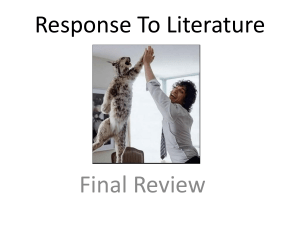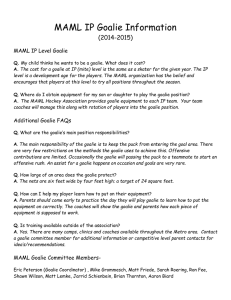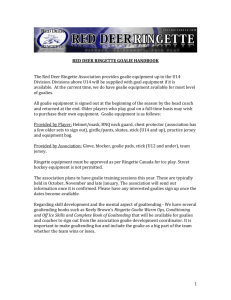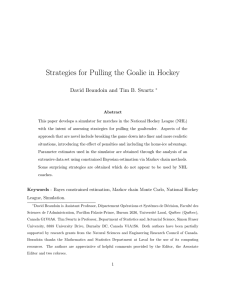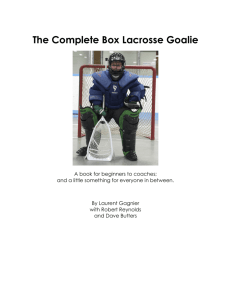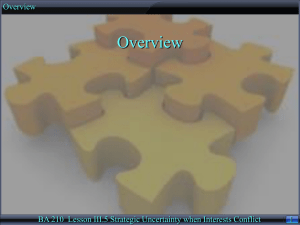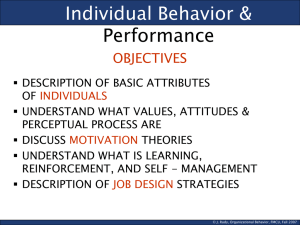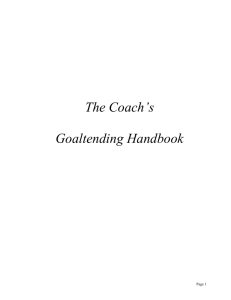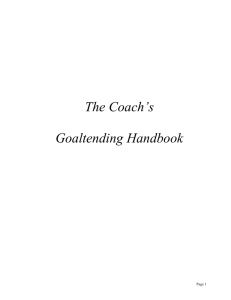Literary Response Review
advertisement
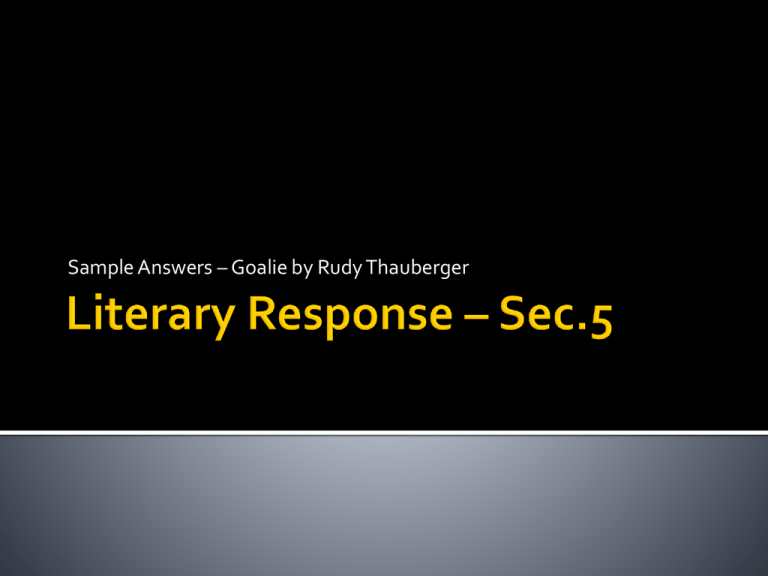
Sample Answers – Goalie by Rudy Thauberger Be sure to clearly state the intended audience. If you can, explain WHY this is the audience (vocabulary, content...) Purpose: Wants us to think about _____. Message: What the author says about _____. Be sure to back up the message with at least 2 quotes or specific examples, and analyze them. Don’t be basic... Try to explain as best you can, in depth. The short story called “Goalie”, written by Rudy Thauberger, is written for teenagers, because the text talked a lot about sports, and also about how the son worked hard for this hobby. This text was written to make us think about the pain and the pressure that players face during this practice time. Therefore, the main message that the author tried to tell us is that people can endure incredible pain and pressure when they’re doing a thing that they really love. In the story, when the goalie starts to practice, he starts to get hurt, but he still insists on doing it. For example, “As practices begin [...] the injuries begin. Bruises. Sprains [...] his ankles buckling under him. His muscles cramp. His nose bleeds. A nerve in his chest begins to knot and fray”. Although he gets a lot of pain from it, he never gives up, as he says in the story: “I love it”. Also, at the end of the story, the father imagines what his son is going to answer about why he does it. He thinks his son might say: “What choice do I have? Whggat else have I ever wanted to do?” This shows that he can endure all the pains when he’s doing the thing he loves as well. The short story “Goalie”, by Rudy Thauberger, must appeal strongly to parents who see their children growing up into adults. Although this boy is a goalie, the story still applies to every child who is so passionate about what they do that they always push themselves to the maximum while getting “bruises” by the hardships they go though to reach their goal. This text was written to truly capture the changes into adulthood of all teenagers. Thauberger’s main message is that although parents may not understand or love what their child wants to do, adults need to always be supportive of their children’s dreams. The narrator really captures this idea when he sees his son bruised and in agony. He says: “You want to ask him why. Why does he do it? Why does he go on? But you don’t ask. Because you Know the answer. You imagine him, looking at you and saying quietly, ‘What choice do I have? What else have I ever wanted to do?’” (3). This father knows that he will never understand his son’s dream, but he is okay with it. He understands that his son truly wants to do this, it is his calling. (continued next page...) This also represents any career choice. It is inevitable that they will be refused or replaced at some point, and their parents will wonder the same questions: why do they do it? Why do they go on? Parents will try to understand their children to see it from their eyes, but it still might not help them any more than before. The narrator attempts this. He wants to know why his son is as in love with the game as he is. “You try to see the game from his eyes,” he explains, “aware of everything, constantly clear. It’s not enough to follow the puck. The position of the puck is old news. The game. You try to understand the game. You fail” (3). The father is very supportive of his son, despite seeing him swollen and in pain, despite not fully understanding his ambition. He is a model of how parents should be: encouraging their children no matter what they do. BE SURE TO MAKE BOTH A TEXT AND A WORLD CONNECTION. When you make the connection, explain both the issue/text, AND refer back to the main story. With the world issue, BE SPECIFIC. Don’t be general. For example, don’t just connect to “Racism”. Connect to “The American South during the Jim Crow Laws”, or “South Africa under Apartheid”. Goalie, by Rudy Thauberger, shows many strong connections with the movie Rocky Balboa. In Goalie, we see a boy that is constantly worn down and sore but, through will alone, carries on. Rocky, played by Sylvester Stallone, is the same way. He knows that he can accomplish great feats, such as defeating his rival, so he never gives up despite injuries, tiredness, and personal issues. Even during the final fight he never surrenders despite almost being killed. Another connection is that they both train hard all year, rain or shine, to reach new levels.In goalie the boy works all summer getting ready for the season using tennis balls and by limbering up. In Rocky, Stallone is seen training much of the movie to be fit for his fight. This text relates to the harshness of professional sports. In the National Football League, the average career length of a linebacker is 3-4 seasons. After that, they are either released due to injuries or too worn down to play any longer. It is a very similar situation in professional hockey. Sprains, concussions, or broken bones cost the career of many athletes. The boy in Goalie portrays this well. He understands the risks of playing hockey but continues anyway. He is not ready to let petty incidents like that get in the way of the National Hockey League. In our main text, we see the son endure all the pain and pressure, trying to be a good goalie, because he loves it. In World War 2, when the Japanese invaded China, all the Chinese started to stand up and protect their own country and land, and although a lot of people died and got injured in the war, they never gave up. People kept fighting, because they loved their country and didn’t want to lose it. So in this issue, people were not afraid of death when they were fighting for their country. It’s the same idea, because a person’s own country is a thing they really love. Be sure to properly identify and define the devices. Give a clear example. Explain why this particular device was used... Be specific ... Avoid generalities (this metaphor lets the reader see the story more clearly). If analyzing a metaphor, why was that metaphor chosen? What does it add to the story? The first literary device I found is IMAGERY. There is both sound and visual imagery. Imagery is a literary device which uses words to describe something in detail. For instance, at the beginning, the son comes home – the author describes the room: “The equipment is everywhere, scattered, draped over chairs, hung on hooks, thrown on the floor [...] His room is the same, pure chaos, clothes and magazines everywhere, spilling out of dresser drawers, into the closer”. This imagery, how he treats his equipment badly and the disorder of his room, shows us his pressure and anger, because he releases all of these my messing up his room and equipment. This helps the reader to understand more about his pressure and pain. In addition, the author uses METAPHOR, which is a description that makes a comparisoin without using “like” or “as”. It appears on the last page, when the son is playing the game. The father says, “You try to move with him, watching his eyes through his cage, and his hands”. The author compares his son’s mask to a cage. It effectively shows the son is miserable, puts himself in a “cage”, and also makes the readers know more clearly about the boy’s pain and pressure. Throughout the story, Rudy Thauberger uses SECOND PERSON PERSPECTIVE constantly. He uses this so the reder connects more strongly to the goalie. They step into the father’s shoes and immediately care for his son as he is injured or unhappy. The way the author puts the reder in this position really brings them close to the son, mostly in situations in which he asks the boy questions: “‘Do you enjoy it?’ you ask. ‘Do you enjoy the game at least?’ He shrugs. ‘I love it,’ he says” (2). Placing “you” is really effective at bringing the reader into the story. There would be much less attachment to him if he used words such as “I” or “The Father”. Thauberger uses a lot of imagery to help establish the goalie’s attitude and personality. He uses many clear adjectives and verbs to paint a very clear picture of what is happening. For example, when his son is returning home, he explains: “His clothes are heavy with sweat. There are spots of blood on his jersey, and on his pads... You hear the thump of heavy leather, the clatter of plastic, the heavy whisper of damp cloth” (1). The vivid picture that Thauberger creates shows how worn out and tired his son is. He has clearly suffered during the match, and the blood and sweat are clear indicators. This is an important image that Thauberger wants to show, as it is the basis of much of the story. His father does not understand how he can keep going on, and thanks to this passage, the reader feels the same way. Explain strengths and weaknesses. Don’t just repeat what you’ve already said. Bring in new ideas (another literary device? A problem you found? A scene you thought was effective) If you can, include a quote from the text that you haven’t yet used. I thought that this text was well written. The story’s message is very important for the intended audience, and it was delivered very clearly. The author’s use of literary devices was effective, and really helped the story to come to life. Overall, I would recommend this story, because the writing was strong, the characters were interesting, and the message is something we can all apply to our life. Overall, I thought that this text was well-written. The overall message of the story is that when people are doing their favourite thing, they can overcome all the difficulties. It is an important message for the intended audience, teenagers, because it tells us never give up our favourite thing; if you want to be a success, you have to pay a lot – do not expect to be a success directly and without paying. Moreover, it’s well developed in the text, because the story talks about how the son practices first, and how he feels bored during the summer without hockey, and then the game, how he spends all his energy on the game. The text is logical and makes it easy for the reader to understand. I agreed with some of the choices the writer made, for instance the use of imagery, which made the story lively and let the reader clearly know what’s going on. At last, I really like this story – I liked the way of writing. In the text the author never mentioned a name, which is very unique. Again, the author described how the son treats his equipment badly at the beginning, so I was thinking he doesn’t like the game. To my surprise, he loves it. This is really interesting and attractive. For these reasons, I think that this text is well written. I thought the text was very well-written. Thaubergers message to parents is that they must be supportive of their children, no matter what they decide to do. It is well developed in the text by showing the worn-down child. The father is very concerned, and fails to understand his extreme love for the sport. However, he accepts that this is what his son wants to do and respects him for that. It is an important message for parents because they are often not this way. Many already have plans for their children and are angry when their children refuse. I agreed with some of the choices Thauberger made. For example, the use of 2nd person narration made the story much more relatable. It is very personal when the father asks questions because it feels like he is answering us directly. It added to the piece greatly because the message was exemplified. It is easier to reflect upon our own life thanks to this perspective. I really enjoyed the way the story was told. It really gave us a detailed view of a child through the father’s eye. Although it was short, I really felt connected to the boy, and the use of imagery made the story very interesting.

